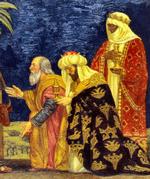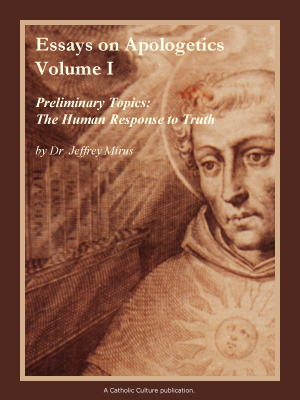Castel Gandolfo: Gardens of the Popes
The summer heat in Rome is difficult to stand. The temperature rises to 35°C (more than 100°F) and high humidity worsens the situation. Those who can avoid spending summertime in the Italian capital leave town to go to the mountains or the seacoast. The mountains next to the city are the Alban Hills surrounding Lake Albano (the hills are of volcanic origin — the lake is the crater of an extinguished volcano).
Already in the time of the Roman emperors, aristocratic families built their opulent villas in these mountains amid the marvelous scenery.
The Emperor Domitian (80-96 A.D.) ordered his architect, Rabirius, to build him a villa on the ruins of the legendary town of Alba Longa. The residence, situated on the edge of the crater, was built on three levels. On the upper level there were the lodgings of the servants and enormous water tanks. The middle level was protected by a huge wall with four nymphaea. The emperor's three-storied palace was situated there, together with a small court theater and long colonnaded terrace which overlooked the coastal plain and the Tyrennian Sea. The lowest, third level contained a cryptoporticus, which still exists — a kind of vast tunnel for walking which protected one from the burning sun in summer, and from wind and rain in winter.
Nearby, a hippodrome was built, below which a vast park and wood extended as far as the via Appia (Appian Way). Domitian was so content in his residence on the Alban Hills that he lived there almost the whole year. Unfortunately, after his death in 96 his splendid palace was abandoned because his successors refused to live in his villa, which was ruined and emptied of its sculptures and marble decorations.
A thousand years later, in the 12th century, the Gandolfi family built a castle on the same site. Thus a new era began in the history of the village, called from then on Castel Gandolfo (the castle of Gandolfis).
In the 13th century, the castle passed to the powerful Roman family Savelli (this family gave the Church two Popes: Honorius III and Honorius IV). Castel Gandolfo belonged to them until 1604, when the village was bought by the Camera Apostolica and became Church property.
The first Pope to turn the castle into a summer residence was Urban VIII. Earlier, as a cardinal, he had often visited Castel Gandolfo because he regarded it as the healthiest place in the Castelli Romani (the Alban Hills from medieval times were also called Castelli Romani — "Roman Castles"). Urban first went there as Pope in the spring of 1626, once the restoration of the palace was completed by Carlo Maderno. Taddeo Barberini, the Pope's favorite nephew, decided to build his villa near his uncle's palace. He bought a part of the ancient Domitian villa and later different plots of land, vineyards and orchards. The workers, brought here by Barberini from the city of Aquila, cleared the land to lay a new garden.
The garden was rather simple and there was no palace or any building in it. To have a princely residence in the garden, Barberini decided to buy the neighboring medieval palace from the Visconti family. The building was rebuilt and adapted to the needs of Barberini and his court.
The year 1626 was the first year of the Popes' vacations at Castel Gandolfo.
Urban VIII's successors often visited their residence in the Alban Hills and tried to embellish it.
Clement XIV enlarged the residence at Castel Gandolfo in 1773, acquiring the adjacent "Villa Cybo," and Alexander VII ordered the construction of the local parish church dedicated to Saint Thomas of Villanova (this holy archbishop of Valencia was canonized in 1658). Clement XI in 1710 conferred on Castel Gandolfo the title of Pontifical Villa (Villa Pontificia) and to its citizens the privilege of being under the jurisdiction of the prefect of the Apostolic Palace.
The Popes "lost" the summer residence when in 1870 the Italian troops occupied Rome, and the Papal States ceased to exist. Pius IX declared himself a "prisoner in the Vatican" and never left the Apostolic Palace.
In this way the Popes lost their ties with Castel Gandolfo for more than 50 years.
The Lateran Treaty between the Holy See and the Italian State, signed February 11, 1929, created an independent State named Vatican City State (Stato della Citta del Vaticano). This small state also included the papal property at Castel Gandolfo.
The papal summer residence consisted of the palace with the adjoining garden of Urban VIII, Villa Cybo, the former Villa Barberini, and large olive groves incorporated later (the whole territory is 55 hectares).
At the request of Pope Pius XII, Emilio Bonomelli rearranged the gardens at Castel Gandolfo. The new Pope's gardens were designed according to the classical principles of landscape gardening and recall the most refined 17th century Italian gardens (so-called giardini all' Italiana). The large-scale work started in June 1930 and lasted two years.
Bonomelli respected the levels of the former Domitian's residence. The present upper level of the gardens, corresponding to the middle level of the emperor's residence, is occupied by the so-called Belvedere Garden (giardino del Belvedere) or simply "the Park." The park is divided into 16 square lawns and embellished with magnificent specimens of Mediterranean and exotic trees. Four nymphaea ornament the wall supporting the upper terrace. On the northern edge of the park is a Roman court theater. On the opposite edge, the Madonna of the Park, a statue sculpted by Angelo Righetti in 1935, stands near a stone-framed pool with water lilies. This charming corner of the garden was the favorite of John Paul II, who spent a lot of time here praying and meditating.
On the lower terrace, the magnificent Italian Gardens are 300 meters long and are divided into several gardens. The first one, which skirts Domitian's cryptoporticus, is divided into four compartments composed of geometric flowerbeds with low hedges (the floral designs of this garden imitate the ceilings of Roman basilicas). The next small garden is composed of four mazes made of clipped hedges with a fountain in the center. Another garden is called the Citrus Orchard (dell'Agrumeto). It consists of 20 lawns decorated with sophisticated floral patterns. In each corner of the lawns orange and lemon trees are grown in big pots. At the end of the garden a row of tall cypresses creates a natural green niche.
Just behind the Citrus Orchard is a charming little garden. In its center a beautiful specimen of Magnolia grandiflora grows; that is why this garden is called the Magnolia Garden. The lawn of a garden is decorated with the floral representation of Pope Pius XI's coat of arms — an eagle with three spheres and a Florentine fleur-de-lis. Nearby there is also a fountain with a statue.
From the Belvedere Garden a monumental stairway descends to the lower levels. The entrance to the stairway is decorated with Pius XI's coat-of-arms, and on the balustrade, flowers in pots are placed.
On the lowest terrace in front of the stairs lies a square called Piazza Quadrata surrounded on three sides by a tall hedge of trimmed trees forming a green arcaded wall resembling ancient aqueducts. Along the hedge, evergreen oaks pruned to form cones grow in two rows. In the middle of the square, the most precious monument from the Roman period is preserved — an equestrian statue in marble (probably this sculpture represents the Emperor Antoninus Pius).
Close to the square, parallel to the Italian Gardens, the Garden of Mirrors (giardino degli Specchi) was arranged. It has vast English-style lawns with two rectangular pools. Their waters mirror the blue sky, white clouds and green trees. In the corners of the pools water lilies grow. The neat lawn is embellished with shrubs shaped into spheres and truncated pyramids. The garden is separated from the Italian Garden on the upper level by a wall with the Fountain of Neptune, whose statue is placed in the central niche.
South of the Piazza Quadrata, the garden becomes a vast park containing a variety of trees and crossed by shady alleys inviting one to walk in. Further south and southeast, the landscape changes again, becoming an olive grove, a vineyard, and a meadow where cows graze. This area is occupied by a pontifical farm, which also supplies food for the Pope's table. Near the farm are situated convents of Poor Clares and Basilian nuns.
The Pope, just like his predecessors, spends part of his vacation at Castel Gandolfo — "the second Vatican." There he can enjoy his beautiful gardens in the Alban Hills, walking, praying, meditating and talking with his closest collaborators. Then his white robe can be seen amid the greenery of this "Mediterranean paradise."
Vladimiro Redzioch is a Polish journalist who lives and works in Rome.
This item 7926 digitally provided courtesy of CatholicCulture.org






